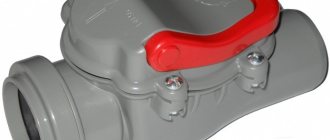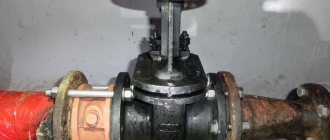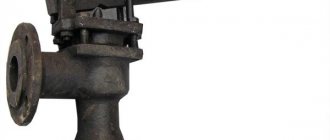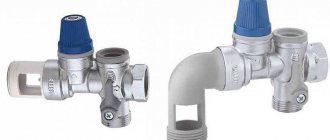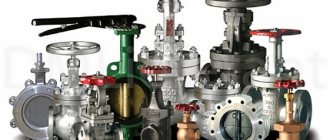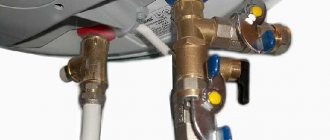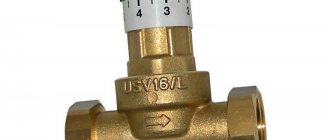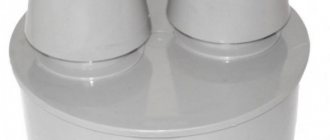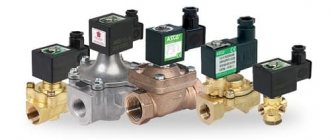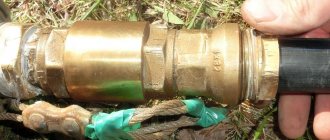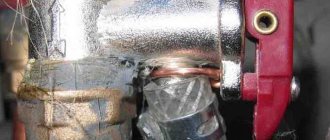Types and purpose of check valves
The dimensions of the check valve are small, but without this little detail it will be impossible to maintain the pressure in the water supply system. It belongs to the category of pipeline fittings whose main task is to prevent a reverse change in the flow of water in the pipes of the water supply system.
Household pumping equipment is not designed for its movement in an abnormal direction.
A check valve is used to allow water flow to flow in only one direction, completely blocking its path back (+)
There are models of pumping stations on the market, the manufacturers of which include a check valve. Such options are supplied with a suction hose with a built-in check valve. But in most cases, you have to purchase this fittings yourself.
Such valves are installed both on the suction line and at the entrance to the internal water supply system immediately after the pump with a hydraulic accumulator or in front of the pumping station.
Depending on the installation location in the water supply system diagram, check valves are divided into:
- Bottom. They prevent the reverse movement of water raised from the source when the pumping equipment is turned off. They create conditions for operating the unit without constant filling with water before starting it and the suction line.
- Pipeline. These include axial and valve varieties. Prevents a drop in the operating pressure in the system.
If there is no check valve at the end of the suction pipe of the pumping station, then when the pump stops, water will begin to flow back under the influence of gravity. As a result, air pockets will form in the line, and under “dry running” conditions, the seals will begin to collapse. As a result, water will penetrate into the electric pump and cause it to burn out.
Not only the starting point of the suction line can be equipped with a check valve. To ensure pressure support, it is installed on the pipeline in front of the pumping station or in front of the hydraulic tank when it is located separately
Most modern pumps are protected against such processes. But water for starting will have to be poured into them after each stop of the unit.
In some pump models, it is possible that the impeller spins up completely, which can lead to its failure. Installation of this fittings on the liquid intake line from the source is mandatory, otherwise no electronic protection will help the water pumping unit.
When connecting several pumping stations into a single unit, check valves protect the switched off unit from the pressure of operating devices
With a pipeline check valve the situation is somewhat different. Here it no longer protects the pump, but the water distribution system inside the house. By locking the water in the pipes, preventing it from returning back to the accumulator, the check valve helps maintain the required operating pressure in the system. Without it, water will rush back into the storage tank, causing it to work abnormally.
Check valves increase the efficiency and reliability of the pumping station, while protecting the pump, plumbing and water system from water hammer. Overall, it is an indispensable device. But the water has to expend effort to open the valve, which reduces the pressure of the flow after its passage by 0.1–0.3 atm.
Question 12: Where should shut-off and shut-off and control valves be installed on vessels?
- on the supply line from a pump or compressor, - on pipelines.
*-on fittings directly connected to the vessel, or on pipelines supplying the vessel and discharging the working medium from it.
- on the fittings.
Question 13: In what cases are temperature measuring devices installed?
*- when their need is determined by the project developer.
- when there is a phase boundary.
- when the vessel is installed in an open area.
-by decision of the organization that owns the vessel
Question 14: Which of the following is indicated on the container label affixed by the manufacturer?
-material of the vessel.
-ambient air temperature.
— capacity.
* - serial (factory) number.
Question 15: Where is permission to put a vessel into operation recorded?
-b changeable journal.
*-in the vessel passport.
-b safety device passport.
-b repair log.
Question 16: Choose a definition for a barrel:
E
jhlorpia* is a cylindrical or other shaped vessel that can be rolled from one place to another or placed on its ends without additional supports, intended for transporting and storing liquid and other substances.
- a vessel with one or two necks for valves, flanges, fittings for transportation, storage and use of compressed, liquefied or dissolved gases under pressure.
- a vessel designed for conducting chemical, thermal and other technological processes, as well as for storing and transporting liquid, gaseous and other substances.
- a vessel installed on the frame of a railway car, chassis of a car or other mobile vehicle intended for transportation, storage of gaseous, liquid and other substances.
Question 17: Where should check valves be installed?
- on pipelines discharging the working medium from the vessel, * - on the supply line from the compressor or pump.
-on drainage pipelines. -on the air bleeder fitting.
Question 18: What is the accuracy class of a pressure gauge?
- true pressure value, - absolute measurement error, - scale range, * - percentage of instrument reading error.
Question 19: Each vessel is supplied by the manufacturer:
*-with vessel passport and instruction manual.
- with instructions for persons responsible for the good condition and safe operation of the vessels.
-with instructions for safe maintenance. -co pressure source circuit.
Bottom check valve
Bottom types of check valves are installed at the inlet of the water pumping line. They are used to equip surface pumping systems to protect against pressure drop.
The purpose of the bottom check valve is to retain water in the system and maintain the operating pressure level (+)
Based on their design specifics, bottom check valves are divided into:
- Spring. Their working locking mechanism consists of a spring and a disk, which, when the spring contracts under water pressure, moves along the body of the device and allows flow to pass.
- Casement . The main organ consists of one or two transverse valves that open under the pressure of pumped water and return to their place when it stops.
Based on the method of attachment to the end of the suction hose or pipe, bottom valves are divided into coupling and flange valves. In tandem with household pumping units, the coupling type is most often used.
Under water pressure, the spring of the device is compressed, and the locking disc attached to it opens the path for flow in only one direction
Coupled connections of check valves are easier to install, but require periodic condition monitoring, especially when working with a vibration pump
A flap check valve is the easiest to operate, repairable version of the device, the flap of which opens only in one direction under the pressure of pumped water (+)
It is recommended to install a strainer in front of the bottom check valve. He must prevent the penetration of biological contaminants and solid particles that have an abrasive effect into the pumping system.
The device must be installed in the direction indicated by the arrow on the housing. The distance from the bottom of the water intake shaft to the check valve must be at least 0.5 - 1.0 m, depending on the class of the unit and the manufacturer’s recommendations. Between the water surface in a well or borehole and the valve there must be a water thickness of at least 0.3 m.
Pumping systems with a submersible pump are equipped with a check valve without a filter, because they are equipped with built-in cleaning devices to protect the functional “filling” from friction. The check valve in this case is installed in front of the supply pipe immediately after the pumping unit. Used to prevent pressure drop in the network.
The check valve in a pumping system with a submersible pump is installed immediately after the unit at the inlet of the suction pipe
How to install a check valve in a heating system?
The modern heating system of a private home is complex and extensive. For its normal functioning, various elements are needed. One of them is a check valve for heating. Where, why and for what purpose these devices are installed, what types and types they come in - we discuss below.
Where is it installed in the heating system?
The general purpose of a check valve is to allow coolant flow in one direction and prevent it from moving back. They do not require power or any other conditions to operate; they operate from the movement of liquids. A check valve for heating is installed in all positions where backflow and parasitic circuits may occur.
In a heating system with several branches, a check valve is placed on the return pipeline. This prevents the pump from “pushing” the flow in the opposite direction.
The same devices are installed in cold and hot water supply. Those intended for heating are distinguished by the fact that materials are used that can withstand prolonged exposure to elevated temperatures. If there are rubber gaskets, then heat-resistant rubber is used. The same applies to plastic parts.
If we talk specifically about heating systems (HC), then a check valve is installed:
- To a bypass with a circulation pump in the piping of a solid fuel boiler - to ensure operation of the system in gravity mode (with natural circulation). In this case, models with the least resistance are installed, which operate easily and quickly - immediately when a flow from natural circulation appears. The function of the valve, in this case, is not to bypass the coolant when the pump is running.
- On the return pipeline when installing an indirect heating boiler. Why install a check valve in this case? To prevent the flow of coolant in the opposite direction when the circulation pump is operating.
- With a branched heating system (for example, on several floors), on each branch. These check valves prevent the coolant from being “pulled” if one of the branches is turned off (when using one circulation pump).
- On the system's cold water make-up line. Here, in addition to the shut-off valve, a return valve is also needed. Since sometimes the pressure in the water supply is lower than in the heating system. Then, when opening the tap to refuel the system, without a check valve, the coolant will “go” into the water supply system. Symbol of the check valve in the diagram
In the diagrams, the check valve is designated as two triangles with their vertices directed towards each other. One of the triangles is shaded. The installation location in the branch is almost any. The main thing is that it exists. The direction of flow is indicated by an arrow on the housing. The coolant flows in this direction. In the opposite case, it overlaps. When installing, carefully follow the arrow (you can also focus on the locking element).
Types of check valves for heating
If you are looking for a check valve for your heating system, be sure to check the operating temperature range. When installed in the return pipeline, the temperature can be 80-90°C, but it still does not rise higher.
When installed in the supply, the requirements are stricter - 110°C and not lower. Otherwise, after a certain period of time, the softened rubber may “stick” and even the pressure from the circulation pump will not be able to move it.
Pressure support check valve
There are several designs of check valves for pipelines with a general operating principle. All of them must ensure unidirectional movement of the working fluid, for which they have a locking mechanism inside. It opens in the direction of the flow, without impeding it, and if there is an attempt to reverse the flow of water, it immediately closes.
When water moves forward, the shutter element in the valve moves to the side, and when it moves in the opposite direction, it closes the pipe tightly (+)
A typical check valve consists of:
- housings;
- shut-off and control element (working body);
- springs (some models do not have them).
The energy of the pressure of water flowing in the forward direction presses the locking element away from the seat, thereby creating a working window for the unhindered movement of liquid. And when the current changes to reverse, this gate, under the action of a spring and water pressure, returns to its original location, blocking the pipeline.
Products of this type of pipe fittings differ in design, the materials used for stamping, and the method of fastening to pipes. At the same time, almost all types of check valves can be used when installing pumping stations, but this is not always practical or advisable.
Design varieties of products
The shut-off element can move parallel, perpendicular and at an angle to the axis of the pipeline. Most often, with dry pipes, it sinks into the seat under its own weight. The device ensures normal pressure in the water supply, preventing the reverse flow of water supplied to the water supply.
Therefore, when installing certain models of check valves, it is necessary to monitor not only the flow direction arrow, but also the correct location of the cover, where the guide for the moving shut-off part is located.
Depending on the design, the shutter inside the check valve moves, rotates or rises (+)
The internal lock in the check valve can be designed as:
- a spool consisting of a rod and locking plates;
- solid or divided into two disc flaps;
- ball with a spring mechanism and sealing gaskets.
In valves with a diameter greater than 400 mm, the disc hits the body quite hard when returning to the seat, which inevitably leads to damage to the device. To avoid premature wear of the valves, such valves are equipped with hydraulic dampers, which make the disk move smoothly.
However, such shockless check valves are not used in everyday life. There are simpler and cheaper analogues on sale.
If you need a small check valve, then you should choose either a ball or double-leaf model. In the first case, a small ball moves inside along and back to the movement of water, and in the second, the pipe is blocked by two halves of the disk attached to one rod. The body of both products is small-sized due to the absence of a moving spool inside with a wide movement step.
There are also non-return type designs with forced opening/closing of the shutter. In this case, the flow is controlled using mechanical or manual devices. However, such check valves are not used in everyday life with pumping stations. It is simply not needed for pumps.
Classification by type of fastening
In addition to design differences in the operating element, check valves used for installation with pumping stations also differ in the method of fastening. The choice here depends on the material of the pipelines and the technology of their connection.
A clutch check valve with a lift-spring mechanism consists of a brass body with threads (1, 2), a spool (3), a spring (4), a spool locking plate (5) and a gasket (6)
Based on the method of connection to pipes, check valves are divided into:
- Couplings.
- Flanged.
- Wafer.
- Welded (for welding).
The first type is connected to pipelines through a threaded transition, and the second is connected using flanges with seals. Wafer check valves do not have their own fastenings at all; they are fixed between the flanges of other water supply elements using long pins.
Image gallery
Photo from
Clutch check valve for water supply systems
Flanged Cast Iron Check Valve
Wafer Disc Valve
Weld check valve
The welded version is more intended for use in pipelines through which aggressive media are pumped. They are not installed with pumping stations. Wafer-mounted check valves are available only in disc or double-leaf versions.
For water supply systems, check valves with a lift-spring locking mechanism and a coupling connection are most often selected. They are easier to install and dismantle, as well as repair them by replacing the spring, which is the weakest link in this pipe fitting.
Wafer products are small in size and quite expensive; they can be installed on pipes both horizontally and vertically
Variations in material of manufacture
The check valve body can be:
- bronze;
- brass;
- cast iron;
- stainless steel;
- plastic.
The most durable models are made from stainless steel; they are least susceptible to corrosion processes. Check valves made from cast iron are bulky, so they are rarely seen in everyday life. They are mainly used on pipes with a large cross-section. Such pipes are not connected to household pumping stations.
The most popular products are made of brass. This metal is relatively cheap, does not rust and is optimally suited to all types of pipes. Plastic products should be taken only for low-pressure lines and polypropylene pipelines.
The main failures of check valves occur due to wear of the spring; for a cottage it is worth choosing a product with the ability to replace it yourself (+)
The working locking element is made of:
- stainless steel;
- aluminum;
- plastics.
In principle, all these materials are equally good. Locking parts are small in size and are always made of high strength and durability. Breakdowns most often occur in the spring mechanism. Therefore, the springs in the vast majority of models are made of stainless steel, which is famous for its anti-corrosion characteristics and reliability.
In stores you can also find combination check valves, the bodies and covers of which are made of different materials. Each manufacturer strives to reduce the cost of its products and offer the market some new product. Fortunately, all fittings are tested; you just need to require a certificate of conformity to the relevant norms and standards.
To achieve tightness of the valve when lowering it into the seat, seals made of rubber, plastics and hard metal alloys are used in various combinations.
